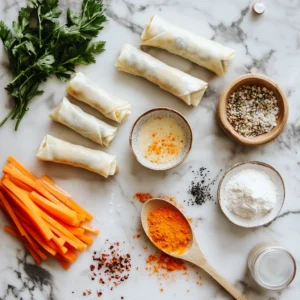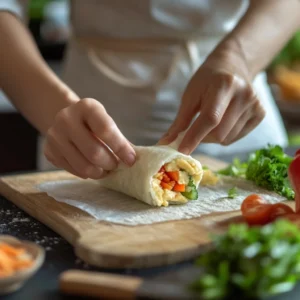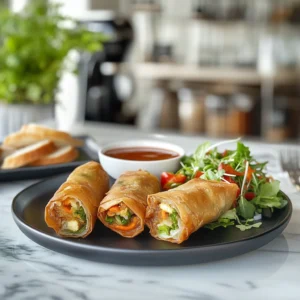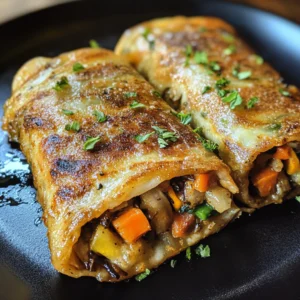Discover the art of creating the perfect vegetable egg roll recipe with this detailed, step-by-step guide. Whether you’re a seasoned chef or a culinary beginner, this article will provide you with all the insights and techniques needed to craft a delicious, crunchy, and nutritious appetizer.
In this guide, you’ll learn everything from selecting the finest ingredients to mastering the art of wrapping and cooking your egg rolls to perfection.
Introduction
Vegetable egg rolls have evolved from a simple street food snack into a gourmet treat served in restaurants around the world. This guide explores the origins, ingredients, and techniques behind this iconic dish, revealing how a perfect balance of flavors and textures can be achieved with fresh produce and careful preparation.
What Are Vegetable Egg Rolls?
Egg rolls are typically made by filling thin wrappers with a medley of vegetables, seasoning them well, and then frying or baking until the exterior is crisp and golden. The result is a satisfying crunch on the outside paired with a tender, flavorful interior.
The Cultural Journey:
Originating from traditional Asian cuisine, vegetable egg rolls have been adapted and transformed over time. Today, they often reflect a fusion of Eastern and Western culinary influences, with innovative recipes that cater to modern dietary preferences. By exploring their history and evolution, you gain an appreciation for the diverse techniques that contribute to the modern vegetable egg roll recipe.
Ingredients and Preparation Essentials

Crafting an outstanding vegetable egg roll recipe starts with selecting the right ingredients and understanding the role each component plays in the final dish. Below are the key elements you need to focus on.
Fresh Vegetable Selection
Choosing high-quality, fresh vegetables is the foundation of your recipe. Consider the following:
- Cabbage:
- Crisp and refreshing, cabbage serves as the primary base.
- Its texture holds up well during cooking, ensuring a satisfying crunch.
- Carrots:
- Provide a natural sweetness and add vibrant color to the filling.
- Julienne or shred them to maintain an even texture.
- Bean Sprouts:
- Contribute an extra layer of crunch and a fresh, delicate flavor.
- They are best added towards the end of the cooking process to preserve their texture.
- Bell Peppers and Onions:
- Offer a burst of color and complexity in flavor.
- Use a mix of red, yellow, or green bell peppers for a visually appealing dish.
- Additional Vegetables:
- You may also include ingredients like shiitake mushrooms, bamboo shoots, or zucchini for extra depth in flavor and nutrition.
Always opt for seasonal produce to ensure maximum freshness and flavor.
Essential Spices and Flavor Enhancers
A well-seasoned filling is key to a memorable vegetable egg roll recipe. Focus on the following spices and sauces:
- Soy Sauce:
- Provides a rich, umami depth that elevates the natural flavors of the vegetables.
- Sesame Oil:
- Adds a subtle, nutty aroma that is indispensable in Asian cooking.
- Garlic and Ginger:
- These aromatics bring a vibrant kick, essential for balancing the sweetness of the vegetables.
- Salt and Pepper:
- A pinch of each is necessary to round out the flavors.
For an in-depth look at blending spices perfectly, visit How to Combine Spices: A Comprehensive Guide.
Egg Roll Wrappers and Alternatives

The wrapper is just as important as the filling. Traditional egg roll wrappers are thin, yet sturdy, and become delightfully crispy when cooked. Consider these options:
- Traditional Wrappers:
- Made from wheat flour, they are the classic choice for egg rolls.
- Rice Paper:
- An excellent alternative for a gluten-free or lighter version of the dish.
- Gluten-Free Options:
- Available in many health stores, these wrappers cater to dietary restrictions without compromising taste.
Experiment with different types of wrappers to find the one that best suits your taste and dietary needs.
Step-by-Step Cooking Process
Crafting your perfect vegetable egg roll recipe requires meticulous preparation and attention to detail. Follow these steps to ensure every roll is crisp on the outside and delicious on the inside.
Prepping and Cooking the Vegetables
The first step is to prepare your vegetables. Here’s how to do it right:
- Washing and Cutting:
- Thoroughly wash all your vegetables to remove any dirt or pesticides.
- Chop them into uniform pieces to ensure even cooking.
- For delicate vegetables like bean sprouts, a gentle rinse is sufficient.
- Cooking Techniques:
- Sautéing:
- Heat a small amount of oil in a large pan over medium-high heat.
- Add garlic and ginger first to infuse the oil with their flavors, then add the vegetables.
- Stir-fry for 3-5 minutes until the vegetables are slightly tender but still retain a crisp texture.
- Blanching:
- Alternatively, you can blanch tougher vegetables such as cabbage.
- Bring a pot of water to a boil and briefly immerse the vegetables for 1-2 minutes.
- This technique softens the vegetables without causing them to lose their crunch.
- Sautéing:
- Recap:
- Wash and chop all vegetables uniformly
- Sauté with garlic and ginger, or blanch as needed
- Keep vegetables crisp and flavorful
For more tips on cutting techniques, explore How to Sharpen a Knife: A Comprehensive Guide.
Assembling the Egg Rolls
The assembly process is critical for a perfect roll. Follow these detailed steps:
- Prepare the Filling:
- Combine the pre-cooked vegetables in a large mixing bowl.
- Ensure that the seasoning is evenly distributed throughout the mixture.
- Setting Up the Wrappers:
- Lay an egg roll wrapper on a clean, flat surface.
- Place a spoonful of the filling in the center of the wrapper.
- Folding and Rolling:
- Carefully fold the sides of the wrapper over the filling.
- Roll the wrapper tightly to form a neat, compact roll.
- Seal the edge with a small amount of water to ensure the roll stays closed during cooking.
- Important Tips:
- Avoid overstuffing the wrapper, as this can cause tearing.
- Practice a few rolls if you’re new to the technique to achieve consistency in size and shape.
Cooking Methods: Frying vs. Baking
Depending on your preference for texture and health considerations, you can either fry or bake your vegetable egg rolls.
Frying:
- Method:
- Heat oil in a deep fryer or a heavy-bottomed pan until it reaches about 350°F (175°C).
- Carefully immerse the rolls in the oil, cooking them in small batches to avoid overcrowding.
- Advantages:
- Frying creates a beautifully crispy exterior and a rich, golden-brown color.
- Considerations:
- Although delicious, frying adds extra calories and requires careful monitoring of oil temperature.
Baking:
- Method:
- Preheat your oven to 400°F (205°C).
- Lightly brush or spray the rolls with oil and arrange them on a baking sheet in a single layer.
- Advantages:
- Baking offers a healthier alternative with less oil, while still achieving a crisp texture.
- Considerations:
- Baking time might be slightly longer, and it’s important to avoid overcrowding the baking sheet to allow even crisping.
Recap:
- Fry for a traditional, crispy finish
- Bake for a healthier, lower-calorie alternative
- Maintain proper temperature and avoid overcrowding for even cooking
For more recipes emphasizing crisp results, check out The Best Bisquick Waffle Recipe Guide: Crispy, Fluffy and Easy.
Tips, Variations, and Serving Suggestions

Enhance your vegetable egg roll recipe by experimenting with different flavors and serving ideas. Here are several ways to elevate your dish:
Dietary Adjustments
- Vegan Alternatives:
- Use rice paper or other vegan-friendly wrappers.
- Ensure that any sauces or seasonings used are free from animal products.
- Gluten-Free Options:
- Opt for gluten-free wrappers available in many health food stores.
- Double-check the ingredients of your sauces to ensure they meet gluten-free standards.
Creative Twists
- Protein Boosts:
- Add tofu or tempeh to the filling for an extra dose of protein.
- These ingredients absorb the flavors of the spices and enhance the overall nutritional value.
- Extra Crunch:
- Incorporate nuts or seeds, such as chopped peanuts or sesame seeds, for additional texture and flavor.
- International Fusion:
- Experiment by adding spices from other cuisines—like a dash of curry powder or chili flakes—to give your egg rolls a unique twist.
- Recap:
- Vegan and gluten-free modifications
- Add tofu or tempeh for extra protein
- Include nuts or seeds for crunch
- Experiment with international spices for fusion flavors
Serving Suggestions & Dipping Sauces
A great vegetable egg roll recipe is elevated by the perfect pairing of dipping sauces and complementary sides:
- Dipping Sauces:
- Sweet Chili Sauce: a classic favorite that provides a perfect balance of sweetness and spice.
- Peanut Sauce: offers a rich, nutty flavor that pairs wonderfully with the crisp rolls.
- Soy-Ginger Dipping Sauce: enhances the Asian-inspired flavor profile with a tangy kick.
- Side Dishes:
- Serve the egg rolls with a fresh salad, steamed rice, or a light soup to create a balanced meal.
- For a varied menu, consider pairing them with our Boneless Buffalo Wings Recipe to create an exciting mix of textures and flavors.
Storage and Reheating Tips
- Storage:
- Store any leftover egg rolls in an airtight container in the refrigerator.
- For best results, let them cool completely before sealing the container.
- Reheating:
- Reheat in an oven or toaster oven to help maintain the crispiness of the wrapper.
- Avoid using a microwave, as this can make the rolls soggy.
Nutritional Information and Health Benefits
Vegetable egg rolls not only satisfy your taste buds but also provide several health benefits, making them a smart choice for a nutritious snack or appetizer.
Caloric Breakdown and Macronutrients
- Low-Calorie Option:
- Compared to meat-filled alternatives, vegetable egg rolls are generally lower in calories, making them an ideal choice for a light snack.
- Rich in Fiber:
- The abundance of fresh vegetables contributes significantly to the fiber content, aiding digestion and promoting a feeling of fullness.
- Vitamins and Minerals:
- Ingredients such as cabbage, carrots, and bell peppers provide essential vitamins and minerals, including vitamin C, vitamin A, and potassium.
Health Benefits
- Antioxidant Properties:
- The use of fresh produce ensures that your egg rolls are packed with antioxidants, which help fight free radicals and support overall health.
- Balanced Diet Integration:
- Incorporating vegetable egg rolls into your meals can help diversify your diet, ensuring a good intake of vegetables and essential nutrients.
- Recap:
- Low-calorie and nutritious
- High in fiber and vitamins
- Rich in antioxidants for overall health
For more nutritional insights and healthy recipe ideas, consider visiting Food Network for additional guidance on balanced eating.
Troubleshooting Common Issues
Even the most well-planned recipe can face challenges. Here are common issues and practical solutions to help ensure your vegetable egg roll recipe is always a success.
Preventing Overstuffing
- Problem:
- Overfilled wrappers can tear or burst during cooking.
- Solution:
- Use moderate amounts of filling.
- Practice the rolling technique on a few test pieces until you master the right balance of filling and wrapper size.
Achieving Consistent Crispiness
- Problem:
- Sometimes egg rolls turn out soggy instead of crispy.
- Solution:
- When frying, maintain the oil temperature around 350°F (175°C) to ensure even cooking.
- If baking, lightly coat the rolls with oil and avoid overcrowding the baking sheet to allow proper air circulation.
- Recap:
- Avoid overstuffing
- Maintain proper oil temperature
- Use appropriate cooking techniques to achieve a crispy finish

Vegetable Egg Rolls
Equipment
- Mixing bowls
- Knife and Cutting Board
- Large Pan or Wok
- Tongs
- Baking Sheet (For Oven Method)
- Deep Fryer or Heavy-Bottomed Pan (For Frying)
Ingredients
- 2 cups cabbage shredded
- 1 cup carrots julienned or shredded
- 1 cup bean sprouts
- 1/2 cup bell peppers thinly sliced
- 1/2 cup onions thinly sliced
- 2 cloves garlic minced
- 1 teaspoon ginger grated
- 2 tablespoons soy sauce
- 1 teaspoon sesame oil
- 1/4 teaspoon salt
- 1/4 teaspoon black pepper
- 12 egg roll wrappers
- oil for frying
Instructions
- In a large pan, heat sesame oil over medium-high heat. Add garlic and ginger, stirring until fragrant.
- Add cabbage, carrots, bell peppers, onions, and soy sauce. Stir-fry for 3-5 minutes until slightly tender but still crisp.
- Remove from heat and mix in bean sprouts, salt, and pepper. Allow filling to cool slightly.
- Lay an egg roll wrapper on a clean surface. Add a spoonful of the filling in the center.
- Fold the sides over the filling, then roll tightly. Seal the edge with a little water.
- For frying: Heat oil in a deep fryer or pan to 350°F (175°C). Fry egg rolls in small batches for 3-4 minutes until golden brown. Drain on a wire rack.
- For baking: Preheat oven to 400°F (205°C). Brush egg rolls lightly with oil and bake for 15-20 minutes, turning halfway through.
- Serve hot with dipping sauces like sweet chili or soy sauce.
Notes
Frequently Asked Questions (FAQs)
Below are answers to some of the most common questions regarding the vegetable egg roll recipe:
- Can I freeze vegetable egg rolls for later use?
Yes, freezing is an excellent option. Ensure the rolls are completely cooled, then wrap them individually before placing them in an airtight container. - What are good substitutes for egg roll wrappers?
Consider using rice paper or gluten-free wrappers if you need an alternative to traditional egg roll wrappers. - How do I ensure my egg rolls stay crispy after cooking?
Proper storage is key. Avoid stacking them while hot, and reheat in an oven to help maintain their crisp texture. - What dipping sauces best complement vegetable egg rolls?
Ideal choices include sweet chili sauce, peanut sauce, and soy-ginger dipping sauce. - Can I bake egg rolls instead of frying them?
Absolutely. Baking is a healthier alternative that still results in a delightfully crispy roll. - How can I make a gluten-free or vegan version?
Simply substitute traditional wrappers with gluten-free or vegan options, and ensure your sauces and seasonings are free from animal products.
For further culinary inspiration, check out our Homemade Pancake Recipe (Small Batch) for creative ideas that can complement your cooking style.
Conclusion and Final Thoughts
In conclusion, this detailed vegetable egg roll recipe guide demonstrates that creating a delicious, crispy, and nutritious dish is within your reach. By focusing on quality ingredients, mastering essential cooking techniques, and experimenting with various twists, you can produce egg rolls that not only taste great but also offer a range of health benefits.
Key Takeaways:
- Start with high-quality, fresh vegetables and season them well.
- Practice the art of rolling carefully to ensure each egg roll is neat and compact.
- Choose between frying for a traditional, crispy texture or baking for a healthier alternative.
- Experiment with creative twists, such as adding tofu for protein or incorporating international spices.
By following these detailed instructions, you will be well-equipped to create a standout vegetable egg roll recipe that is perfect as an appetizer or a light meal. Enjoy the process, and let your creativity shine through in each roll you prepare.
Bon appétit!

